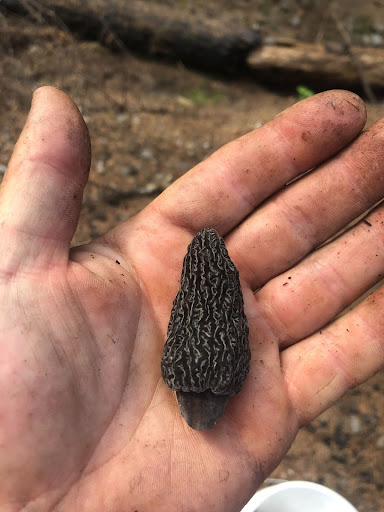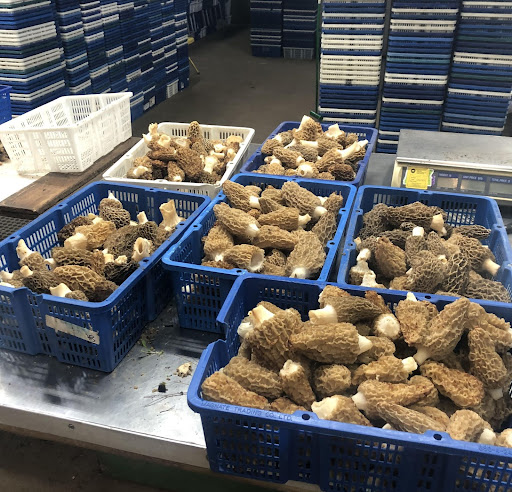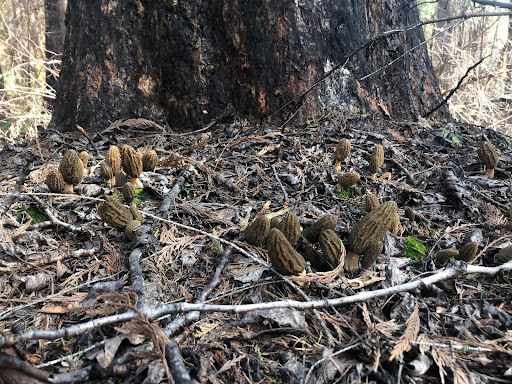When the first warm days of spring come and bring flowers and gobbling turkeys, I get itchy to do one thing. Well…Many things actually as a lover of the outdoors, but one activity that captures me and ensures I will leave before daylight and come home after the sun sets with dirty clothes, blackberry scratches, a delicious meal and a handful of cash because it’s Morel season. In this article I will go over some tips on how to become a better forager. If you’re someone who in the past has collected a few in a grocery bag, then get ready to bring home full buckets!
Before You Leave the House
First and foremost familiarize yourself with morels and their few look-alike species. I recommend downloading apps such as mushroom observer and naturalist. Even though you may know which morels are edible, these are great tools to help you identify down to the species level and further refine your patterning.
Make a plan on where you plan to forage for Morels. I recommend using some mapping software such as OnX, Google Earth, or Avenza to look for likely areas and drop pins for areas you would like to go. Depending on where you are geographically you will be looking for different habitats. On the west coast, a lot of the effort is focused on benches and terraces of wildfire scars. Across the continental divide you’re looking for mesic (moist, but not wet) site bottomlands that contain soft hardwoods. Don’t ever trespass so ensure you have legal access to public land wherever you choose to go. If you do not have a lot of public land around you, plan to knock on some doors to ask folks for permission. Often if you offer some of your harvest or do some farm chores for them they will give you permission. The night before I go I ensure I have my baskets, knife, rain-gear, hand shears and a cooler ready to go in the car. I have ice packs in the freezer for the cooler (in case the car gets hot between spots) and my coffee ready to go.
Getting There
While I am driving to my spot I am often looking for others as I go. I will periodically stop and scan for suitable habitat and look at some mapping software like OnX to see if there is public access. When I find a chunk of ground that looks good I will find a place to park the car. Now parking the car may seem like the simplest task of the day, but let me assure you that if you found a honey hole and your car is out there for all to see, then you may have turned everyone else onto where the good foraging is at. Sometimes you won’t have a choice, but if I have the chance I make sure I pull down the road where my car is less visible or park my car in a place slightly deceptive.
Also, consider that most folks are looking for easy access. I recommend taking the risk and beating the brush and finding areas that are off the beaten path. It is a higher risk, but there is a much higher reward. Whatever you do, be sure you are safe and feel safe. A windy day in a fire scar is a bad place to be. I can’t go into every scenario in this article so use some common sense.

Screenshot of OnX map with historic wildfire highlighted in orange and deciduous tree raster file in red.
Note that property boundaries are delineated with landowner info.
Finding The Goods
Some folks will meander around an entire 40 acre parcel, but until I know there are mushrooms there I am “running and gunning”. There ain’t no sense to spend all day poking around when you are not sure if there are mushrooms there yet. What I will do is charge through an area fairly quickly and only stop when I see the highest quality habitat in the area. While “running and gunning” I am looking for the plants and habitats most highly associated with Morels. (Refer to the Table 1 at the end of this article for morel-plant associations.) This is when I will dive deep into it. This area is never a very large one, ranging maybe from a 20-100’ diameter. Early in the season I look only in areas with openings where sunlight can reach the soil as these areas are the first to warm up. Later in the season you have to beat brush and get low. By low I mean looking under the nastiest brush and blackberries. Often this means getting down flush on my belly. Once I find a spot holding Morels, I will start to grid the area out thoroughly ensuring not to miss any good habitat. After I finish picking this spot I go on the hunt for the next.
Setting Up the Milk Run
A Milk run is a fishing term referring to having an understanding of the patterns of the quarry you are chasing, where they are located, and having several spots where you know you can find them with certainty. I use a GPS to mark all my spots and will mark good spots within a spot to make sure I don’t miss any of the goods. You can do the same with morel hunting. Once you get into the rhythm you can go out for a day and string together several spots where you’re pulling out 30+ pounds before lunch time! There are a few key tactics to making this successful.
First, just because you did not find morels at a location the first time you visited does not mean they will not be there in the future. Consider this just a part of your future scouting. What is the aspect of the hillside? What is the elevation? Is significant canopy cover or brush keeping the soil cooler than more open sites? These are sites to revisit later. Sometimes they do not produce a single Morel even though they look juicy, but you will never find those jackpot areas if you only go where you see other people picking.
Next, hit your spots that get the most pressure from other mushroom hunters first. Most days I’m still sore from the day before, but you have to wake up and get out there before the sun is up and other people are already picking. I will then hit my next busiest spot and so on. If none of your spots are highly trafficked then hit your highest producers first and leave the afternoon for more scouting, exploratory missions or swimming in the river.
As the season progresses your top producing spot will change so you will have to change your rhythm with the weather and elevation. As the season progresses some of your spots will have slower regrowth of morels. When this occurs I will give some spots a day or two to rest and regrow. That being said, I will try and hit every spot the day after a warm rain.

The elusive M. tomentosa
Managing Your Morels
Taking care of your morels is vitally important if you plan to sell them and also it is much nicer to have clean mushrooms for your own consumption. When collecting I cut the mushroom below the cap leaving the residual mycelium and stem butt. I recommend leaving morels that are sunburned, mushy or waterlogged as it will decrease the quality of those in your basket and besides it is good to leave some to finish their life cycle to ensure we have morels to pick in the future. Folks have varying preferences concerning what they like to tote their haul around the woods in ranging from baskets, crates, backpacks, packboards etc. However I like a couple of five gallon buckets with holes drilled in them for airflow and spore dissemination. I will also bring some paper towels out with me to layer between layers of morels in the buckets after a recent rain to keep them from getting mushy. I like a bucket lid if I am going through thick brush so I do not knock debris and moisture into my bucket.
I bring several buckets with me in my car and if the air is cool they can be stored between spots just fine this way. If it is warm out however I will transfer them to a large cooler with ice packs. Mushroom care is critical. Once they are picked they can deteriorate in harsh conditions quickly. I have had long days where mushrooms that were stacked to deep in coolers, got too hot or too wet and were downgraded to #2 grade in which case the price difference per pound between grade #1 and #2 can be 30 dollars or more! Remember that they are fragile and treat them as such.
Selling Your Haul
You don’t have to sell them. For years I had refused to because I enjoyed them for myself so much. They are great to surprise your friends and family with and when dried they make great birthday or Christmas gifts. But at the end of the day it is awfully difficult to eat through 25 pounds. Besides, if you love foraging, selling morels keeps you out in the field enjoying your hobby and can put some money in your pocket.
If you go out planning to sell your excess, first call all the local mushroom buyers in your area (Seen below) and ask what their buying price is and ask what they want to see from you. Some buyers want you to cut just below the cap and others are less picky. Try a few buyers in your area and see which one you like the best. I recommend bringing smaller hauls to new buyers so if you don’t like their style you’re not hosed out of too much money. The buyers are usually good folks so make friends with the ones you like and help them out however you can. Their job is hard too and if you help them out they will help you out.

Selling the daily haul to the local mushroom buyer
If you do not have an established mushroom buyer in your area or you would like to make more money than they are offering you can sell on etsy, craigslist or go door to door to restaurants. Dealing with restaurants is best dealt with ahead of mushroom season and getting a confirmation of what quantity of weight they can deal with is recommended. Restaurants will often pay you more money, however it is often much more work on your end and you are dealing with a perishable product. What morels you cannot sell immediately are best dried for sale later. Dried morels you can sell all year long until next season. More on this in a future article.
Final Thoughts
Be sure that however you collect them, do it in a legal safe manner. Check to see if you need a permit to collect on the land that you are going to. Some public lands you can collect an amount in pounds before you need a permit. Double check your access. Make sure you do not trespass and if access seems questionable don’t be afraid to knock on folks doors and ask for permission to cross their property.
Morel hunting is an extractive use so make as little impact on the land as possible. Pick up trash and don’t create defined trails. Also, leave some morels to complete their life cycle so we all have some for the future. If you are making money off of them I urge you to donate a small portion of your earnings to a conservation organization that benefits public lands and the flora and fauna on it. It is a fight to keep good quality public land in public hands!
Remember, when you see other mushroom hunters out there that yes it is competitive, but be courteous and kind. They are trying to do the same thing as you and if you show respect to them they will show respect to you. For some folks out there this is how they feed their family. We are all out there to have fun, not grumble about someone else in “our spot”. Public land is public! Have fun and happy hunting!
Table 1
Each species has specific associations. This table is a reference for where to look for communities of morels not specific species. To find specific species research the ecology species specific. Also, just because I have a species listed as weak does not mean it could not be strong in your area. Morels rarely follow the rules. This is simply a reference and I encourage you to figure out the unique patterns of growth for your area. Not every species is listed either for ease of use of this table.
| Plant Species | Burn Morels M. tomentosa M. eximina M. capitata M. rufobrunnea M. sextelata |
Western (non-burn) M. americana M. snyderi M. populiphila* M. Brunnea |
Eastern M. americana M. angusticeps M. cryptica M. Virginiana M. Punctipes* M. Diminutiva |
Landscape/ Non-associated M. importunna M. rufobrunnea |
|---|---|---|---|---|
| Cottonwood Poplar |
Very Strong | Very Strong | Very Strong | – |
| Ash | Weak | Strong | Very Strong | – |
| Maples | Present | Strong | Very strong | – |
| Fruit Trees | Present | Strong | Very Strong | – |
| Elm | – | – | Very Strong | – |
| Oaks/Madrone | Strong | Present | Present | – |
| Doug Fir | Very Strong | Weak | – | – |
| Western Red Cedar | Very Strong | – | – | – |
| Hemlock | present | Weak | – | – |
| Cherry | – | Present | Strong | – |
| Other Soft- Hardwood | present | Present | Strong | – |
| Other Hard-Hardwood | Strong | Present/weak | Present | – |
| Pine/True Fir | strong | Strong | – | – |
| Garden/Parks Lawns |
weak | Present | Present | Strong |
| General Disturbance | strong | Strong | Strong | Strong |
*M. punctipes and M. populiphila can cause intestinal distress for some so eat with caution. Try only a bite or two and wait a day. In my opinion they don’t taste as good either. Use your own judgment.
